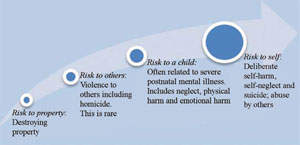10.4 Assessing the general risks from mental illness
Concerns about risk in relation to mental illness relates to the management of potential harm. Here ‘harm’ has several distinct meanings, depending on the form it takes and at whom it is directed. There are three broad categories of risk: risk to self, risk to others and risk to property. Hence, risk management means thinking about the harm posed to the mentally ill person as a direct or indirect result of their mental illness (including self-inflicted injury and harm caused to the ill person by others), and about the harm that those with mental illnesses might pose to other people or property (Figure 10.4). These risks are more common in people with SMI, although they can occur with any form of mental illness.
It is important to realise that the fear of people with mental illness is far worse than the evidence suggests it should be. People with mental illness rarely pose a risk to others, although this is unfortunately not understood by many of the general public, who continue to hold irrational fears about people with mental illness. In fact, people with mental illnesses are far more likely to be attacked and abused by others than they are to behave aggressively or violently themselves. In Ethiopia, people with SMI tend to die from injury-related causes much more often than others in the general population. This is also reflected in the fact that the most common form of harm associated with mental illness is self-harm through neglect.
10.3.1 What to look out for in a person with SMI

